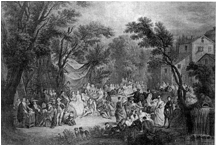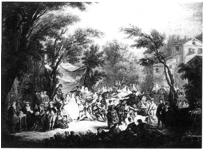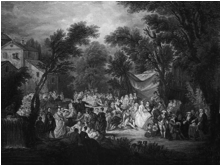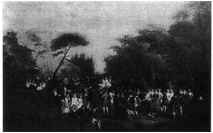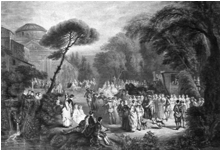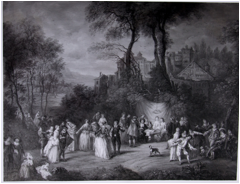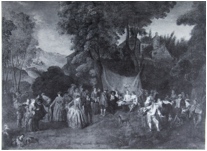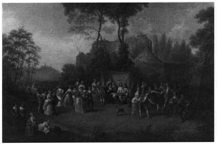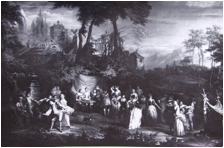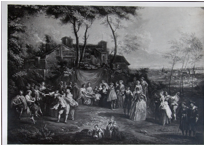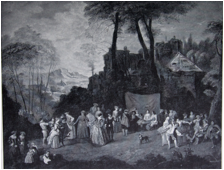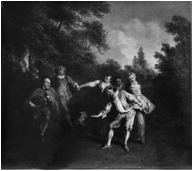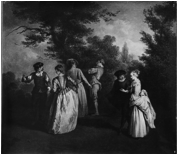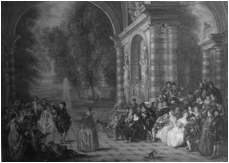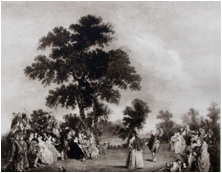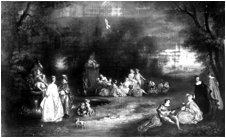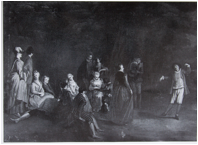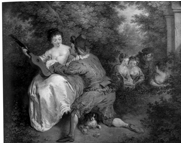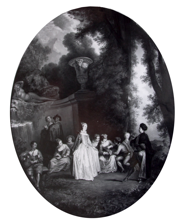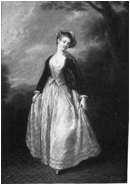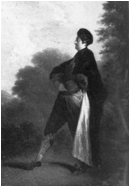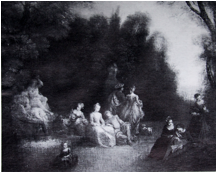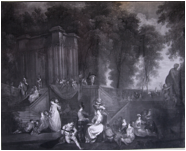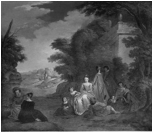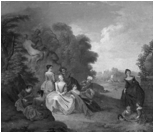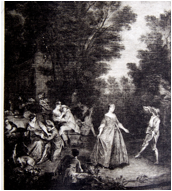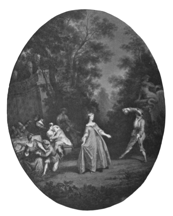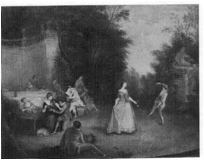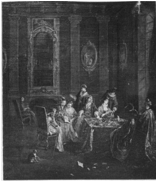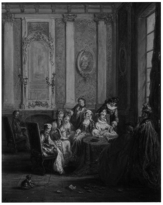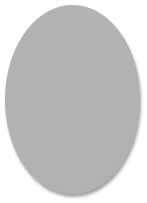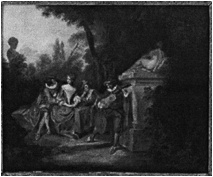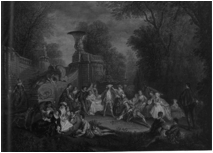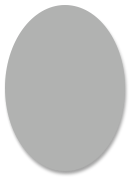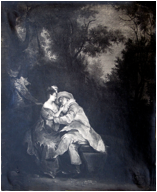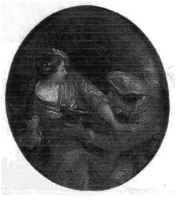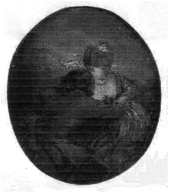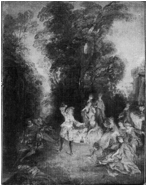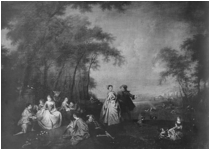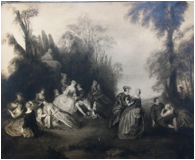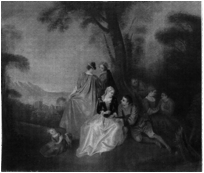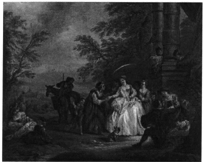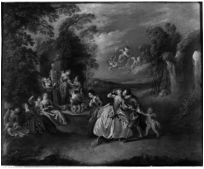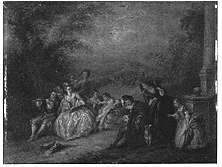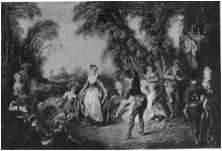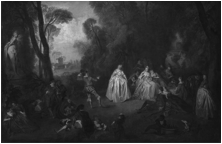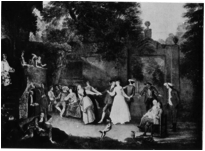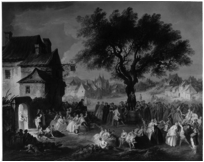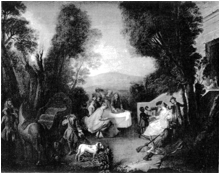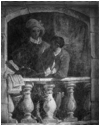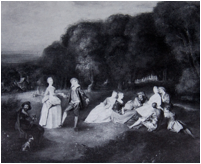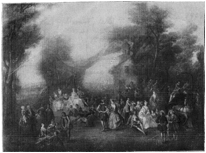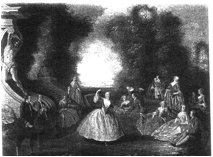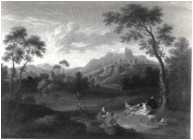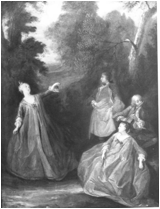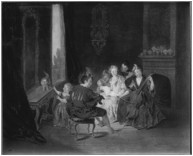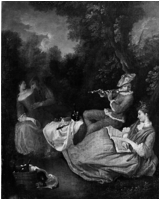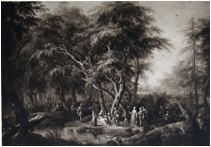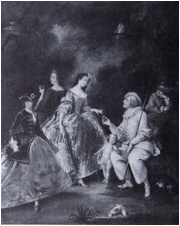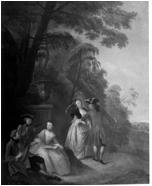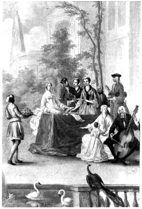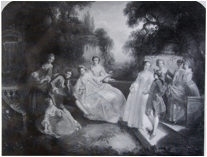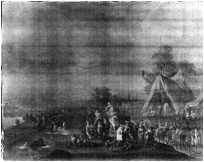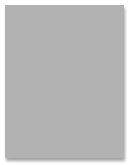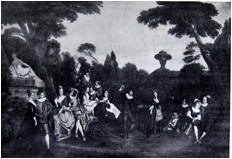Defining the Oeuvre of Bonaventure de Bar (Part 2)
© Martin Eidelberg
Created September 30, 2011
Click to Print or Download PDF Version of Part 2-A
Click to Print or Download PDF Version of Part 2-B
Click to Print or Download PDF Version of Part 2-C
The first portion of this study established a corpus of paintings clearly attributable to Bonaventure de Bar, especially because many of the pictures are linked to eighteenth-century documents. That inquiry brought together twelve extant paintings as well as references to as many other works recorded in the eighteenth century. As small as this number may seem, the extent of de Bar’s known oeuvre is remarkable since this relatively minor painter practiced his art for less than a decade. These works establish a benchmark against which we can judge others attributed to him in modern times. Indeed, an incredibly large number of paintings have been attributed to de Bar and his school (as though he had one!) in the last century and a half. The more than one hundred paintings that follow in this section have been wrongly ascribed to him in sale catalogues and other printed references. This list encompasses an impossibly wide variety of styles and subjects, and these, in turn, have contributed to our misunderstanding of the painter’s true artistic identity.
Around 1900, when few of de Bar’s works were known save for his morceau de réception in the Louvre, similarly ambitious, multi-figured fête galantes, such as the one in the 1907 Sedelmeyer sale (cat. X71), were often given to de Bar. Simpler compositions with a Flemish accent, such as the paintings that we now know were executed by Pierre de Angellis (cat. nos. 59-60), were attributed to de Bar by Robert Rey. Each generation has had its conception of what sort of artist de Bar was. The paintings that follow are mostly fêtes galantes and scenes of the commedia dell’arte in the manner of Watteau and his school, and this represents the modern view of the artist. It would be tedious to explain in each instance why these paintings are not by de Bar but, now that we have a clearer sense of what he actually did execute, it suffices that none of them resemble the corpus of authentic, documented paintings that has been assembled. In some instances I have been able to offer alternate name such as Pierre Antoine Quillard and François Octavien, but many pictures remain in the limbo of unidentified masters.
As the corpus of verifiable works by de Bar establish, he was a creative and independent artist. There is no evidence to suggest that he was a mere plagiarist or copyist, yet more than half of the paintings that follow are straightforward copies or variants of well-known compositions by Watteau, Lancret, and Pater. The idea that de Bar was largely a plagiarist can be traced in large measure to Rey, who denigrated the painter as a “methodical and naïve plagiarist.”1 Ironically, Rey published anonymous copies after Lancret’s Autumn and Winter (cat. nos. X31, X34) as being by de Bar without realizing that they were just copies. Recently Guillaume Glorieux accepted the idea that two such copies after Lancret’s Autumn, each different from the other (cat. nos. X31-32), are by de Bar."2 While it is true that Lancret’s Autumn belongs to a series of Four Seasons commissioned by de Bar’s patron, Lériget de la Faye, this does not justify the attribution of the copies of either seasonal allegory to de Bar. As the right-left orientation of the copies shows, they were derived not from Lancret’s original canvases but, rather, from the engravings made after them by Nicolas Tardieu and Jacques Philippe Le Bas.3 As the engravings were issued after de Bar’s death, it would have been impossible for de Bar to have copied them. There are many other such instances where de Bar’s supposed copies were based on prints issued after his death, thereby ruling out any possibility that he was the copyist (e.g., cat. nos. X11-12, X14-17, X22, X24, X27). But even when the sources were available in de Bar’s lifetime, the stylistic characteristics of these copies have no actual relation to de Bar’s documented works. Why have so many such unworthy paintings been wrongly attributed to de Bar and why is the mention of their true sources often repressed? Unfortunately, this is not an uncommon practice in the art market where, not wanting to acknowledge that the pictures are only copies, auction houses and dealers pass such works off as originals by secondary, unfamiliar artists—painters such as de Bar.
For the greater part, I have refrained from speculating on which of the following works are eighteenth-century or more recent pictures because I have not seen many of them first hand. Moreover, my prime focus is de Bar and not the copyists and pasticheurs.
---------------------------------------------------------------
1. Rey, Quelques satellites de Watteau, 143: “Ce plagiat méthodique et naïf nous amuse plus qu’il ne nous indigne.”
2. Glorieux, “Un Ensemble de décors peints par Bonaventure de Bar,” 50.
3. These engravings were announced in June 1730 and permission to publish them was granted on August 6, 1730. On these paintings and their engravings, see Mary Tavener Holmes, Nicolas Lancret 1690-1743, exh. cat. (New York: The Frick Collection, 1992), 70, cat. no. 6.
Notes on the Use of the Catalogue
The dimensions are generally those most recently cited; height precedes width.
Titles of paintings are rendered in English and have been standardized, except that the French titles of Watteau’s paintings have been retained in accord with general usage.
References to Watteau’s compositions bear the prefix “MM” and refer the reader to the catalogue numbers assigned by Giovanni Macchia and Ettore C. Montagni, L’opera completa di Watteau (Milan: 1968). References to Lancret’s compositions are followed by the prefix ”GW” and the catalogue numbers assigned by George Wildenstein, Lancret (Paris: 1924). References to Pater’s compositions are followed by the prefix “IS” and the catalogue numbers assigned by Florence Ingersoll-Smouse, Pater (Paris: 1928).
|
X1. The Village Wedding 54.5 x 74 cm, oil on panel Whereabouts unknown Provenance: Rosina O. Bateson collection, with X6 as pendant; New York, Christie’s, Nov. 11, 1978, lot 63, as Bonaventure de Bar, with X6 as pendant.
Despite its supposed “Watteau” signature, this picture copies the 1760 Cardon engraving after de Bar’s Village Wedding, and therefore must date at least three decades after the death of de Bar. Pairing this picture with a copy after the engraving of Watteau’s La Mariée de village is typical of the spurious art made for the market. For another copy after Cardon’s print, see the painting signed and dated “J.J. Hubert 74” sold New York, Christie’s, Oct. 15, 1992, lot 111.
|
|
X2. The Village Wedding 26.7 x 35 cm, oil on panel Whereabouts unknown Provenance: London, Christie’s, Feb. 9, 1979, lot 148, as “Bonaventure de Bar (after Watteau),” with X16 as pendant; New York, Christie’s, Jan. 15, 1986, lot 70, as “attributed to Bonaventura del Bar,” with X16 as pendant.
This picture copies the Cardon engraving after de Bar’s Village Wedding and therefore must date after 1760.
|
|
X3. The Village Wedding 26.7 x 34.9 cm, oil on panel Whereabouts unknown Provenance: London, Christie’s, April 3, 1992, lot 46, attributed to the “manner of Jean Antoine Watteau.”
Curiously, although this picture is identical in size and support to the preceding painting, it is in the opposite direction and it is paired with a copy after a different Watteau composition, La Mariée de village (MM 63).
|
|
X4. The Village Bride 72.5 x 91 cm, oil on canvas Whereabouts unknown Provenance: Paris, Galerie Pardo, c. 1969-75, as Bonaventure de Bar.
This picture copies Watteau’s La Mariée de village in Charlottenburg (MM 63).
|
|
X5. The Village Bride 130 x 195 cm, oil on canvas Whereabouts unknown Provenance: Tours, Etienne Monnier coll., c. 1941-60.
This picture copies the engraving after Watteau’s La Mariée de village (MM 63), but it has extended the composition longitudinally.
|
|
X6. The Village Bride 54.5 x 74 cm, oil on panel Whereabouts unknown Provenance: Rosina O. Bateson collection, with X1 as pendant; New York, Christie’s, Nov. 11, 1978, lot 63, as Bonaventure de Bar, with X1 as pendant.
This picture copies the engraving after Watteau’s La Mariée de village (MM 63).
|
|
X7. The Village Bride Dimensions unknown, oil on canvas Whereabouts unknown Provenance: Paris, c. 1928, with the dealer George Aubry, as Bonaventure de Bar, with X12 as pendant.
Most of the figures in this picture are derived the engraving after Watteau’s La Mariée de village (MM 63), but the landscape setting as well as the boy and dog in the foreground appear to be the copyist’s own inventions.
|
|
X8. The Wedding Contract 25.4 x 33.6 cm, oil on canvas Whereabouts unknown Provenance: London, Christie’s, Feb, 9, 1979, lot 148, as “Bonaventure de Bar (after Watteau.”
This picture copies Watteau’s L’Accordée de village in the Sir John Soane’s Museum (MM 127).
|
|
X9. The Wedding Contract 58.5 x 80 cm, oil on canvas Whereabouts unknown Provenance: reputedly London, Lord Battersea; Mrs. Humphrey Ward; Cleveland, Ohio, Elisabeth Severance Prentiss coll., as Antoine Watteau; Cleveland, Museum of Art, E.S, Prentiss bequest, 1944, as Antoine Watteau; New York, Sotheby Parke Bernet, Nov. 28, 1978, lot 174, as Bonaventure de Bar; New York, Sotheby Parke Bernet, Jan. 20, 1983, lot 2, as Bonaventura de Bar; London, Harari and Johns; Paris, Galerie Segoura; private collection, as Watteau.
This sketchily rendered picture copies Watteau’s L’Accordée de village in the Sir John Soane’s Museum (MM 127) save that some of the figures in the left foreground have been omitted and the trees are fuller. Despite a belief in the nineteenth and early twentieth centuries that this was actually by Watteau, and despite the recent resurrection of that attribution, accepted by Guillaume Glorieux (Watteau [Paris, 2011], 187, 190), I believe it is nothing but a poor copy of the master’s painting. The briefly proposed attribution to de Bar is equally without merit.
|
|
X10. The Wedding Contract 62.5 x 91.4 cm, oil on canvas Whereabouts unknown Provenance: Rome, Christie’s, Dec. 6, 2001, lot 280, as “circle of de Bar.”
This picture copies Watteau’s L’Accordée de village in the Sir John Soane’s Museum (MM 127).
|
|
X11. The Wedding Contract 65 x 98 cm, oil on canvas Whereabouts unknown Provenance: London, Christie’s, Apr. 1, 1966, lot 70, as Bonaventure de Bar; London, Sir Richard Ford coll.; London, Christie’s, Dec. 13, 1974, lot 117, as Bonaventure de Bar; Earl Spring coll.; New York, Sotheby Parke Bernet, June 7, 1978, lot 154, as Bonaventure de Bar.
This picture copies the engraving after Watteau’s L’Accordée de village (MM 127), a print issued in 1735, more than fifteen years after de Bar’s death. Some of the figures in the right foreground of the engraving have been omitted. When the painting was sold in 1966, it was claimed that it bore de Bar’s name but this claim was not repeated in subsequent sales of the painting.
|
|
X12. The Wedding Contract Dimensions unknown, oil on canvas Whereabouts unknown Provenance: Paris, c. 1928, with the dealer George Aubry, as Bonaventure de Bar, with X7 as pendant.
This picture copies the engraving after Watteau’s L’Accordée de village (MM 127), and therefore it must have been executed more than fifteen years after de Bar’s death. Some of the children who appear in the right foreground of the engraving have been moved to the center foreground of the painting.
|
|
X13. Village Wedding 71.1 x 88.9 cm, oil on canvas Whereabouts unknown Provenance: Paris, Hôtel Drouot, May 24, 1923, lot 7, as “attributed to Bonaventure de Bar–after A. Watteau;” London, Walter J. Abraham coll.; London, Christie’s, July 28, 1933, lot 32, as Bonaventure de Bar; London, Palser Gallery, 1933, as Bonaventure de Bar.
This picture copies Watteau’s L’Accordée de village in the Sir John Soane’s Museum (MM 127).
|
|
X14. A Country Dance 24.8 x 27.9 cm, oil on canvas Whereabouts unknown Provenance: London, Agnew, 1921, as “school of Pater,” with X15 as pendant; (?) New York, A.J. Kobler coll., with X15 as pendant; New York, Parke Bernet, Apr. 22, 1948, lot 15, as Bonaventure de Bar, with X15 as pendant.
This picture copies several of the principal figures at the right side of the engraving after Watteau’s L’Accordée de village (MM 127). Therefore, this work must have been executed more than fifteen years after de Bar’s death. However, the landscape is quite different.
|
|
X15. A Country Dance 24.8 x 27.9 cm, oil on canvas Whereabouts unknown Provenance: London, Agnew, 1921, as “school of Pater,” with X14 as pendant; (?) New York, A.J. Kobler coll., with X14 as pendant; New York, Parke Bernet, Apr. 22, 1948, lot 15, as Bonaventure de Bar, with X14 as pendant.
This picture copies several of the principal figures at the left side of the engraving after Watteau’s L’Accordée de village (MM 127). Therefore, this work must have been executed more than fifteen years after de Bar’s death. However, the landscape is quite different.
|
|
X16. The Pleasures of the Dance 26.7 x 35 cm, oil on panel Whereabouts unknown Provenance: New York, Christie’s, Jan. 15, 1986, lot 70, as “attributed to Bonaventura de Bar,” with X2 as pendant; London, Christie’s South Kensington, Oct. 25, 1990, lot 108 (illustrated in reverse), with X40 as pendant.
The paintings sold in 1986 and 1990 agree in size and support, and it would seem that they are one and the same. The change in left-right direction of the second painting may be just a mistake in the printing of the sale catalogue. However, the shifting of pendants between 1986 and 1990 typifies the mysteries (or trickery) of the marketplace.
This picture copies the engraving after Watteau’s Les Plaisirs du bal (MM 164), a print first published in 1730. Therefore, this copy must have been executed at least a year after de Bar’s death.
|
|
X17. The Pleasures of the Dance 66 x 83 cm, oil on canvas Whereabouts unknown Provenance: Stockholm, Bukowski, Apr. 4, 1949, lot 95, as Bonaventure de Bar; Stockholm, Bukowski, April 2-3, 1952, as Bonaventure de Bar.
The figures in this pictures are copied from the engraving after Watteau’s Les Plaisirs du bal (MM 164), and therefore the painting must have been executed at least a year after de Bar’s death. Whereas Watteau’s composition depicted an architectural environment, here the scene is set in a non-eighteenth-century landscape,.
|
|
X18. Fête Galante at a Statue of Bacchus 36.5 x 59.3 cm, oil on panel Whereabouts unknown Provenance: Czechoslovakia, Daniel Vogel coll.: Rumson, New Jersey, Ferdinand Peter Vogel coll.; New York, Parke Bernet, Apr. 18, 1956, lot 58, as Bonaventure de Bar; New York, Sotheby’s, June 11, 2011, lot 93, as Christian Wilhelm Ernst Dietrich (with the claim that the work had been given c. 1988 to the seller by William Frederick Cavendish-Bentinck, 9th Duke of Portland [1897-1990]).
Despite the alternative attributions that have been proposed, this picture remains merely an anonymous copy after the engraving of Watteau’s Le Bosquet de Bacchus (MM 141).
|
|
X19. Fête Galante 79.3 x 113 cm, oil on canvas Whereabouts unknown Provenance: Amsterdam, Roos, Nov. 18, 1913, Schalken coll., lot 55, as “attributed to Nicolas Lancret;” London, Christie’s, Apr. 18, 1991, lot 51, as “follower of Bonaventura de Bar.”
This picture copies the engraving after Watteau’s La Musette (MM 93).
|
|
X20. Scene Galante 23.5 x 29 cm, oil on copper Whereabouts unknown Provenance: Paris, Hôtel Drouot, Mar. 26, 2003, lot 73, as “attributed to Bonaventure de Bar.”
The two principal figures are taken from the engraving after Watteau’s Le Conteur (MM 132), but not the additional figures, the landscape, or the architectural elements.
|
|
X21. Fête Galante 64 x 79 cm, oil on canvas Whereabouts unknown Provenance: Versailles, Palais des Congrès, Mar. 3, 1968, lot 146, as “attributed to Bonaventure de Bar.”
This picture copies a Watteau fête galante in Charlottenburg, Les Comédiens sur le champ de foire (MM 62 bis), but adds highly detailed architecture at the right.
|
|
X22. Fête Galante 90 x 71 cm, oil on canvas Whereabouts unknown Provenance: Monaco, Sotheby Parke Bernet, May 26, 1980, lot 568, as Bonaventure de Bar, with X32 as pendant; London, Sotheby Parke Bernet, Apr 8, 1981, lot 189, as Bonaventure de Bar, with X32 as pendant.
This picture copies the engraving after Watteau’s Fêtes vénitiennes (MM 180), a print first issued in 1732. Therefore, this painting must have been executed more than seven years after de Bar’s death. That it recast Watteau’s composition in an oval format, and paired it with a copy after a Lancret (X32) tells us something about the deceptive nature of the plagiarist.
|
|
X23. Woman Dancing 29.2 x 21.5 cm, oil on panel Whereabouts unknown Provenance: New York, Christie’s, April 6, 1989, lot 33, as “circle of Bonaventure de Bar,” with X24 as pendant.
Although described as the “portrait of a lady” when auctioned in 1989, this painting copies the principal figure in Watteau’s La Danse paysanne, now in the Huntington Library, San Marino (MM 134).
|
|
X24. Man Dancing 29.2 x 21.5 cm, oil on panel Whereabouts unknown Provenance: New York, Christie’s, April 6, 1989, lot 33, as “circle of Bonaventure de Bar,” with X23 as pendant.
Although described as the “portrait of a gentleman” when auctioned in 1989, this painting copies the principal male figure (actually a portrait of Nicolas Vleughels) in the engraving after Watteau’s Les Fêtes vénitiennes (MM 180). The print appeared in 1732 and therefore this painting and its pendant must have been executed more than twelve years after de Bar’s death
|
|
X25. Fête Galante 78.7 x 97.2 cm, oil on canvas Whereabouts unknown Provenance: Marquess of Hamilton; London, Christie’s, Feb. 6, 1976, lot 62, as Bonaventure de Bar, with X27 as pendant; London, Sotheby’s, Dec. 11, 1991, lot 73, as “circle of Jean-Antoine Watteau,” with a provenance from the Duke of Abercorn.
Most of the elements in the left half of this picture, as well as the architecture at the right, were taken from the engraving after Watteau’s La Mariée de village (MM 63). However, the principal female dancer and the group behind her are taken from the engraving after Watteau’s Les Fêtes vénetiennes (MM 180). Her partner seems to have been derived from the principal male figure in Watteau’s La Proposition embarassante (MM 146).
|
|
X26. Fête Galante with a Fountain of Bacchus 32 x 41 cm, oil on canvas Whereabouts unknown Provenance: London, Sotheby’s, April 16, 1980, lot 288, as “School or follower of Watteau;” Paris, Hôtel Drouot, Mar. 30, 1981, lot 9, as “attributed to Bonaventure de Bar.”
The fountain, the landscape setting, the guitarist at the right, and the leftmost couple are derived from the engraving after Watteau’s Le Bosquet de Bacchus (MM 141). The couple seated at the very center of the composition appears to be based on the engraving after the Watteau arabesque Le Berger assis (MM 49F). The strolling couple in the background is a frequently recurring motif in Watteau’s works such as L’Assemblée galante and L’Amour paisible (MM 71, 174).
|
|
X27. Fête Galante 80 x 100.5 cm, oil on canvas Whereabouts unknown Provenance: Marquess of Hamilton; London, Christie’s, Feb. 6, 1976, lot 63, as Bonaventure de Bar, with X25 as pendant.
This composition is a pastiche from several sources. The guitarist is derived from the engraving after Watteau’s La Récreation italienne (MM 129), an engraving published four years after de Bar’s death. The woman repulsing her suitor at the right seems to depend on a similar couple in Watteau’s Fêtes vénitiennes (MM 180). The statue of Venus and Cupid at the right is taken from the engraving after the Berlin Embarkation or the Dresden La Fête d’amour (MM 185 and 178). The park setting and especially its elaborate staircase suggest the work of painters from the generation after Watteau, including Lancret and Lajoue.
Although presented in 1976 as a pendant to another pastiche (X25) the two pictures differ considerably. This picture is slightly larger but the figures are smaller in scale than those in its supposed pendant.
|
|
X28. Fête Galante 29.8 x 34.3 cm, oil on panel Whereabouts unknown Provenance: London, Christie’s, June 1, 1953, lot 71, as Jean Baptiste Pater, with X29 as pendant; London, Christie’s, May 19, 1989, lot 69, as Bonaventure de Bar, with X29 as pendant.
Despite the previous attribution to Pater and the present attribution to de Bar, this picture and its pendant are pastiches after the works of several artists. The woman in the left foreground seems to have been derived from Pater’s La Danse in Sans Souci (IS 223), while the male guitarist at the right is related to the one in Watteau’s L’Accord parfait in Los Angeles (MM 196). The couple strolling away seem to be based on figures in Watteau’s Fête d’amour in Dresden (MM 178).
|
|
X29. Fête Galante 29.8 x 34.3 cm, oil on panel Whereabouts unknown Provenance: London, Christie’s, June 1, 1953, lot 71, as Jean Baptiste Pater, with X28 as pendant; London, Christie’s, May 19, 1989, lot 69, as Bonaventure de Bar, with X28 as pendant.
As with its pendant, this composition was constructed from diverse sources. The guitarist at the left was based on one in Watteau’s La Perspective (MM 117), and the girls at the right seem derived from the engraving after his Champs Elysées (MM 156). On the other hand, the blackamoor pouring a beverage is a favorite motif in Pater’s fêtes galantes such as one in Valenciennes (IS 29), while the fountain with its mermaid and river god is a composite of elements employed by Lancret for his fountains (GW 9 and 149).
|
|
X30. Fête Galante 71.1 x 96.5 cm, oil on canvas Whereabouts unknown Provenance: New York, American Art Association, April 18-19, 1934, lot 167, as Bonaventure de Bar; bought by the New York dealer, Julius H. Weitzner.
Although the picture was not illustrated at the time, it was described as showing a park in the evening. Groups of people are at either side, and a central group watches a theatrical performance that is accompanied by a violinist. The supposed signature “A. WATTEAU” at the lower left was evidently insufficient to persuade experts to ascribe it to him. I doubt that de Bar’s name should have been intoned as an alternative.
|
|
X31. Fête Galante 52 x 46 cm, oil on canvas Whereabouts unknown Provenance: Paris, Hôtel Drouot, Dec. 19, 1913, lot 3, as Bonaventure de Bar, pendant with X34)
Neither the 1913 auction catalogue nor Robert Rey (Quelques satellites de Watteau, 150-51) recognized that this picture is wholly dependent on a composition by Lancret, Autumn, from a series of Four Seasons originally owned by Lériget (GW 9; see also Holmes, Lancret, cat. no 6). While Glorieux (“Un Ensemble de décors peints par Bonaventure de Bar,” 52 and note 25) recognized its dependence on Lancret, he failed to realize that this picture copies the engraving after Lancret’s composition, which was not published until mid-1730. Therefore, this copy must have been executed at least half a year or more after de Bar’s death.
|
|
X32. Fête galante 90 x 71 cm, oil on canvas Whereabouts unknown Provenance: Monaco, Sotheby Parke Bernet, May 26, 1980, lot 568, as “Bonaventure de Bar (after Lancret),” with X36 as pendant; London, Sotheby Parke Bernet, Apr.8, 1981, lot 189, as Bonaventure de Bar, with X36 as pendant.
This picture copies the engraving after Lancret’s Autumn (GW 9) but recasts it in an oval format. Glorieux (“Un Ensemble de décors peints par Bonaventure de Bar,” note 25) accepted the attribution of this work to de Bar. However, it was based on the engraving after Lancret’s composition, issued in June 1730, and therefore this copy must date at least a half year or more after de Bar’s death.
|
|
X33. Fête Galante 69.9 x 90.2 cm, oil on canvas Whereabouts unknown Provenance: Paris, Bailliencourt coll.; Paris, A. Picard coll.; New York, American Art Association, Oct. 21, 1937, lot 46, as Bonaventure de Bar.
When the painting was in France, it was classified as a “copy after Nicolas Lancret” (as per indications on a photograph in the Service de documentation of the Louvre). This picture copies the engraving after Lancret’s Autumn (GW 9) but recasts it in a horizontal format and distends the spaces between the figures.
|
|
X34. Interior with Card Players 52 x 46 cm, oil on canvas Whereabouts unknown Provenance: Paris, Hôtel Drouot, Dec. 19, 1913, lot 4, as Bonaventure de Bar, with X31 as pendant.
This picture copies the engraving after Lancret’s Winter (GW 10) and thus must date after June 1730, that is, at least a half year after de Bar’s death.
|
|
X35. Interior with Card Players 25.1 x 20.1 cm, oil on copper Whereabouts unknown Provenance: New York, Christie’s, May 31, 1991, lot 248, as “circle of Bonaventure de Bar.”
This picture copies the engraving after Lancret’s Winter (GW 10) and thus must date after June 1730, that is, at least a half year after de Bar’s death.
|
|
X36. Fête galante 90 x 71 cm, oil on canvas Whereabouts unknown Provenance: Monaco, Sotheby Parke Bernet, May 26, 1980, lot 568, as “Bonaventure de Bar (after Lancret),” with X22 as pedant; London, Sotheby Parke Bernet, Apr. 8, 1981, lot 189, as Bonaventure de Bar, with X22 as pendant.
When this painting was sold in 1980 and 1981, it was not described or illustrated. Since its pendant was a version of one of Lancret’s Four Seasons, it is possible that this picture was based on another season in that cycle.
|
|
X37. Fête Galante 37.6 x 46.5 cm, oil on canvas Whereabouts unknown Provenance: La Romieu, France, Château de St. Aignan, private coll.; New York, Christie’s, Oct. 3, 2007, lot 951, as “follower of Bonaventure de Bar;” Vienna, Dorotheum, Apr. 16, 2008, lot 233, as Jean Baptiste Pater.
This picture copies a Lancret composition engraved under the title Country Relaxation (GW 271).
|
|
X38. Fête Galante 23.8 x 32 cm, oil on panel Whereabouts unknown Provenance: London, Sotheby’s, Oct. 28, 2010, lot 141, as “circle of Bonaventure de Bar,” with X39 as pendant.
This picture copies Lancret’s Le Concert pastoral (GW 272), the original of which was sold in New York, Sotheby’s, Jan. 24, 2008, lot 97. However, this copy omits some of the landscape background, a fountain, and a second child. Also, the child holds a rabbit rather than a dog.
|
|
X39. Fête Galante (The Bird’s Nest) 23.4 x 31.5 cm, oil on panel Whereabouts unknown Provenance: London, Sotheby’s, Oct. 28, 2010, lot 141, as “circle of Bonaventure de Bar,” with X38 as pendant.
Although not illustrated in the 2010 sale catalogue, this picture was described as showing a couple looking at a bird’s nest and, presumably it too copied a Lancret composition, perhaps The Bird Nest in the Louvre (GW 456) or a picture formerly in the Boileau collection (GW 339).
|
|
X40. Blind Man’s Buff 26 x 34.8 cm, oil on panel Whereabouts unknown Provenance: New York, Christie’s, Jan. 10, 1990, lot 94, as “circle of Bonaventure de Bar;” London, Christie’s South Kensington, Oct. 25, 1990, lot 108 (illus. in reverse), as “attributed to Bonaventure de Bar,” with X16 as pendant; New York, Christie’s, Jan. 11, 1995, lot 249, as “circle of Bonaventure de Bar,” without a pendant.
If this is the correct left-right orientation of the picture, then this work copies the engraving after Lancret’s Blind Man’s Buff in Potsdam (GW 226). The presence and then the loss of the pendant (a copy after a Watteau composition), typifies the issues of the marketplace.
|
|
X41. Two Archers Practicing on the Grounds of a Country House 56 x 45.8 cm; oil on canvas Whereabouts unknown Provenance: London, Bonham’s, July 29, 1976, lot 194, as “De Bar” (signifying a work of his school or one of his followers).
This picture, although not illustrated in 1976, may copy Lancret’s Youth (GW 32), part of an allegorical series devoted to the Four Ages of Life.
|
|
X42. Elegant Company Playing Backgammon in a Park 35.5 x 40.5 cm, oil on canvas Whereabouts unknown Provenance: London, Bonham’s, March 4, 1976, lot 3, as “B. de Bar” (signifying a work of his school or one of his followers), with X43 as pendant.
Although not illustrated or further described in the sale catalogue, the unusual subject suggests that this picture probably copies Lancret’s After Dinner (GW 36),part of an allegorical series devoted to the Four Times of Day.
|
|
X43. Genre Scene 35.5 x 40.5 cm, oil on canvas Whereabouts unknown Provenance: London, Bonham’s, March 4, 1976, lot 3, as “B. de Bar” (signifying a work of his school or one of his followers), with X42 as pendant.
Although not illustrated or described in the sale catalogue, like its pendant, this picture perhaps copied another of the scenes in Lancret’s allegorical series devoted to the Four Times of Day (GW 34-35, 37).
|
|
X44. Scène Galante with Commedia dell’Arte Characters 58 x 46 cm, oil on canvas Whereabouts unknown Provenance: London, Christie’s, July 25, 1924, lot 160, as Nicolas Lancret, with The Bird Cage as pendant; bought by London dealer Frank T. Sabin; Cologne, Lempertz, Dec. 12, 1992, lot 6, as “attributed to Bonaventure de Bar.”
This picture excerpts three characters from the left side of the engraving after Lancret’s Autumn (GW 9), and thus must have been executed after June 1730, that is, at least a half year after de Bar’s death. The fate of its pendant, Bird Cage, is not known, nor do we know if it too was subsequently attributed to de Bar. It is probably a vertical adaptation of a well-known Lancret composition (GW 458, 459).
|
|
X45. Scène Galante 8.6 x 8.3 cm, oil on copper Whereabouts unknown Provenance: Monaco, Sotheby’s, June 30, 1995, lot 61, as Michel Barthélemy Ollivier, with X46 as pendant; New York, Christie’s, May 23, 1997, lot 99, as Bonaventure de Bar, with X46 as pendant; New York, Christie’s East, June 3, 1998, lot 112, as Bonaventure de Bar, with X46 as pendant; Zurich, Schuler Auktionen, June 21, 2002, as Bonaventure de Bar, with X46 as pendant.
This picture excerpts figures from the left side of the engraving after Lancret’s Autumn (GW 9) and therefore must date after June 1730, that is, after de Bar’s death.
|
|
X46. Scène Galante 8.6 x 8.3 cm (or slightly smaller), oil on copper Whereabouts unknown Provenance: Monaco, Sotheby’s, June 30, 1995, lot 61, as Michel Barthélemy Ollivier, with X45 as pendant; New York, Christie’s, May 23, 1997, lot 99, as Bonaventure de Bar, with X45 as pendant; New York, Christie’s East, June 3, 1998, lot 112, as Bonaventure de Bar, with X45 as pendant; Zurich, Schuler Auktionen, June 21, 2002, as Bonaventure de Bar, with X45 as pendant.
Like its pendant, this picture probably excerpts figures from one of Lancret’s compositions (such as GW 285, 294, 295, 335) but, if so, it is a free transcription.
|
|
X47. Fête Galante 40.6 x 30.5 cm, oil on canvas Whereabouts unknown Provenance: New York, Koetser Gallery, c. 1943; Brewster collection; New York, Sotheby’s, May 19, 1995, lot 127, as Bonaventure de Bar.
This sketchily rendered picture seems close in spirit to Lancret and his school. The male dancer can be compared with Lancret’s Wedding Celebration in Angers (GW 515).
|
|
X48. Fête Galante 86.4 x 111.8 cm, oil on canvas Whereabouts unknown Provenance: New York, Ehrich Galleries; New York, Anderson Galleries, Nov. 12, 1924, lot 36, as Bonaventure de Bar; bought by Marshall Field & Co., Chicago; (?)London, Margaret, Lady Illingworth coll.; London, Christie’s April 3, 1992, lot 47, as “follower of Jean Antoine Watteau.”
This picture is related to a Pater composition with many variants. It is perhaps closest to a painting in Potsdam; see Christophe Martin Vogtherr et al., Stiftung Preussische Schlosse und Gatern Berlin-Brandenburg, Französische Gemälde I, (Berlin: 201I), 239-44.
|
|
X49. Fête galante 66 x 81 cm, oil on canvas Whereabouts unknown Provenance: Brussels, Fievez, de Fursac coll., Dec. 14-15, 1923, lot 171, as Jean Baptiste Pater; Paris, Galerie Charpentier, 1926, as Bonaventure de Bar.
This picture copies one by Pater in the Wallace Collection (IS 50) but adds several figures at the right.
|
|
X50. Fête Galante 18.25 x 21.75 inches, oil on canvas Whereabouts unknown Provenance: New York, Parke Bernet, May 10, 1961, lot 30, as Bonaventure de Bar.
This picture seems to imitate a composition by Pater but no specific source has been found.
|
|
X51. Fête Galante 64.5 x 53 cm, oil on canvas Whereabouts unknown Provenance: Paris, Hôtel Drouot, Oct. 19, 2007, lot 89, as “attributed to Bonaventure de Bar.”
This picture is an enlarged copy of Pater’s Swing in the Wallace Collection (IS 276).
|
|
X52. The Fortune Teller 18.8 x 23.9 cm, oil on canvas Whereabouts unknown Provenance: Amsterdam, Christie’s, May 11, 1994, lot 128, as Bonaventure de Bar.
This picture is derived from a well-known Pater composition with many variants, one of which was sold from the Hodgkins collection in 1927 (IS 517bis).
|
|
X53. A Military Encampment 30 x 38 cm, oil on copper Whereabouts unknown Provenance: London, Sotheby’s, Dec. 6, 1989, lot 254, as “attributed to Bonaventure de Bar.”
This picture copies Pater’s Encampment, of which there are several versions such as the one in Lord Roseberry’s collection at Mentmore (IS 415).
|
|
X54. Fête Galante (Blind Man’s Bluff) 65.8 x 82 cm, oil on canvas Whereabouts unknown Provenance: London, Charles Goding [sic] collection; London, Christie’s, Mar. 14, 1891, lot 41, as “B. de Bar;” Charles Goading [sic] collection, c. 1970; London, Phillips, July 2, 1991, as “studio of Jean-Baptiste Pater,” London, Christie’s, Dec. 13, 1991, lot 215, as Bonaventure de Bar; Paris, Hôtel Drouot, Dec. 13, 2005, lot 43, as Jean Baptiste Pater.
This picture is one of several copies after Pater’s Blind Man’s Buff in Potsdam (IS 292)
|
|
X55. Fête Galante 18.5 x 23.9 cm, oil on panel Whereabouts unknown Provenance: Paris, Christie’s, June 26, 2003, lot 71, as “follower of Bonaventure de Bar.”
This picture copies Pater’s painting in Buckingham Palace, London (IS 18).
|
|
X56. The Kiss 19 x 24.6 cm, oil on canvas Whereabouts unknown Provenance: London, Christie’s South Kensington, July 4, 1996, lot 278, as “circle of Bonaventure de Bar.”
This picture copies the engraving after Pater’s The Rendered Kiss (IS 473), published in 1733, four years after de Bar’s death.
|
|
X57. Country Dance 25.5 x 38.5 cm, oil on panel Dresden, Gemäldegalerie Alte Meister, inv. 788 (before 1753).
This picture is the pendant to a painting by Pater also in the Dresden museum and was traditionally ascribed to him. It is not of the highest quality, perhaps due to repainting, but a recent attempt to associate it with de Bar has no justification. See Pierre Rosenberg, Gesamtverzeichnis französische Gemälde des 17. und 18. Jahrhunderts in deutschen Sammlungen (Bonn, 2005), 62, cat. no. 237.
|
|
X58. Fête galante 75 x 114 cm, oil on canvas London, National Gallery, inv. no. 4079. Provenance: John Webb collection; Edith Cragg (daughter of John Webb) collection; bequeathed in 1924 to the London National Gallery.
The earlier attribution of this painting to the School of Watteau (e.g., National Gallery, Illustrations to the Catalogue, British, French & Spanish Schools [1926] 144) is without merit. The majority of critics have recognized the picture to be by a follower or imitator of Pater (e.g. Martin Davies, London National Gallery, French School [1946], 72-73). Ingersoll-Smouse was undoubtedly too harsh in judging it to be a nineteenth-century imitation of Pater (Pater, 55, under cat. no. 234 bis). Exceptionally, Adhémar (Antoine Watteau, sa vie—son oeuvre [1950], 236, cat. no. 248) described this work as “School of Watteau (Bonaventure de Bar?), after ...Pater” but the painting bears no relation to de Bar’s oeuvre.
|
|
X59. The Village Dance 53 x 72 cm, oil on canvas Whereabouts unknown Provenance: Paris, Hôtel Drouot, Dec. 19, 1930, lot 27, as “French School, 18th Century,” with X60 as pendant.
Robert Rey (Quelques satellites de Watteau, 157) attributed this painting and its pendant to de Bar, but allowed that they were commercial, less careful works. Karl T. Parker (“Mercier, Angélis and De Bar,” Old Master Drawings, 7 [Dec. 1932], 36-40) properly recognized the author to be Pierre d’Angellis.
|
||||
|
X60. The Village Feast 53 x 72 cm, oil on canvas Whereabouts unknown Provenance: Paris, Hôtel Drouot, Dec. 19, 1930, lot 27, as “French School, 18th Century,” with X59 as pendant.
For this picture, which was not illustrated or described at the time, see the entry above for X59.
|
||||
|
X61-64. The Four Seasons 43.2 x 31.7 cm, oil on canvas Madrid, Museo Thyssen-Bornemisza Provenance: London, Christie’s, May 6, 1927, lot 14, as Bonaventure de Bar; Paris, with Louis Paraf, 1927, as Pierre Antoine Quillard; Lugano, Thyssen-Bornemizsa collection, as Pierre Antoine Quillard.
Although this set of Four Seasons was not illustrated when it was sold in 1927, the descriptions of the allegories, their oval format, and their measurements allow us to identify the works with the well-known cycle of Quillard paintings, now in Madrid, whose provenance prior to their appearance in Paris was not previously known.
|
||||
|
X65.Women Bathing in the Countryside 73.7 x 91.4 cm, oil on canvas Whereabouts unknown Provenance: Paris, Broussand de la Barre collection; Count Armand de Marcy collection; Washington, D.C., Audrey Maynard Auchincloss collection; New York, Sotheby’s, May 21, 1998, lot 138, as “attributed to Bonaventura de Bar;” New York, Sotheby’s, Jan. 28, 2011, lot 93, as “attributed to Bonaventure de Bar.”
Despite the attempted association with de Bar, this composition has all the hallmarks of a work by Pierre Antoine Quillard in terms of the exaggerated bodily proportions, the arrangement of the figures in small clusters, and the dramatic chiaroscuro.
|
||||
|
X66. Fête in a Tavern Courtyard 80 x 102 cm, oil on canvas Whereabouts unknown Provenance: Paris, Hôtel Drouot, May 23, 1911, lot 15, as Bonaventure de Bar; Mme. De Batbedat (circa 1930); Paris, collection L.D.; Paris, Hôtel Drouot, June 17-18, 1936, as “French School (18th Century),” lot 167; Paris, Galerie Cailleux, as Pierre Antoine Quillard; Croix (Nord), Pollet-Beghin collection, c. 1938, as Pierre Antoine Quillard.
Although the 1911 attribution of this picture to de Bar was seconded by Robert Rey (Quelques satellites de Watteau, 156-57), its true authorship by Quillard was recognized by the mid-1930s.
|
||||
|
X67. Fête Galante 66 x 91 cm, oil on canvas Whereabouts unknown Provenance: Paris, with Jules Feral, 1927, as Bonaventure de Bar; London, Christie’s, July 20, 1990, lot 81, as “follower of Jean-Baptiste Pater.”
In 1927, when the painting was given to de Bar, it was claimed that it was signed and dated. A later attempt to associate this picture with Pater is not any more convincing. An attribution to one of the Octavien family is perhaps more appropriate. It resembles the fêtes galantes sold in Paris, Palais Galliera, Dec. 4, 1968, lot 28, and London, Sotheby’s, Dec. 10, 1980, lot 45.
|
||||
|
X68. Rest during the Hunt 55 x 70 cm, oil on panel Whereabouts unknown Provenance: Brussels, Palais des Beaux-Arts, Feb. 27-28, 1973, lot 6, as Bonaventure de Bar.
This finely wrought picture appears to be French, painted c. 1720-40, by a yet-to-be identified master.
|
||||
|
X69. Decorative Murals Dimensions and medium unknown Château de Condé-en-Brie (Aisne)
These murals are situated in a country residence acquired in 1719 by Jean François Lériget. They are in poor condition and suffer from a “restoration” undertaken around 1900 which seems to have included the overpainting of many of the surfaces. The series is attributed to Watteau by the present owner of the château, and is attributed to de Bar by Guillaume Glorieux (“Un Ensemble de décors peints par Bonaventure de Bar,” Revue de l’art 150 [2005], 47-54). While certain images, such as the fête with a seated woman surrounded by several men and a standing hunter, do recall motifs in de Bar’s paintings, the scene of the man and woman dancing is a direct quotation from Lancret’s Autumn. While Glorieux would have us believe that de Bar was a pasticheur, the evidence does not support such a premise. I believe that the Condé-en-Brie murals were painted by a lesser artist, a decorative painter who intentionally imitated Lancret, de Bar, and other artists whom Lériget patronized. For the work of such decorative painters, see the example of a six-part screen which was sold in Paris, Galerie Charpentier, Dec. 10, 1935, lot 33, attributed to a follower of Lancret, and which reappeared (lacking one leaf) in New York, Sotheby’s, Jan. 28, 2000, lot 92, with an attribution to Lancret himself.
|
||||
|
X70. Country Fête 52 x 63.5 cm, oil on canvas Whereabouts unknown Provenance: New York, Sotheby Parke Bernet, Nov. 16, 1979, lot 93, as “attributed to Bonaventure de Bar.”
While unrelated to de Bar, this is a charming painting in its own right. One of the young men seated in the right foreground recalls a similar character in Watteau’s Les Fêtes vénitiennes (MM 180), but this artist has a specific manner of his own, and seems distinct from the other Watteau satellites painting in France around 1720-40.
|
||||
|
X71. Village Fête 73 x 91 cm, oil on canvas Whereabouts unknown Provenance: Paris, Sénateur Boitelle collection; Paris, Hôtel Drouot, Jan. 10-11, 1867, lot 15, as Bonaventure de Bar; Paris, Hôtel Drouot, May 16-18, 1907, Sedelmeyer coll., lot 170, as Bonaventure de Bar; Paris, Hôtel Drouot, June 2, 1909, lot 5, as Bonaventure de Bar; Paris, Hôtel Drouot, April 27, 1921, lot 16, as “attributed to Bonaventure de Bar;” Paris, Hôtel Drouot, May 24, 1923, lot 7, as “attributed to Bonaventure de Bar;” Paris, Hôtel Drouot, April 9-10, 1930, lot 102, as “attributed to Bonaventure de Bar;” Germany, coll. Field Marshal Hermann Goering; sold by the French Commission for Artistic Recuperation, 1948; Paris, Galerie Pardo, c. 1948-51; Uruguay, Barreiro collection; Montevideo, Uruguay, Castells & Castells, Nov. 14-15, 1996, lot 107, as Bonaventure de Bar.
This ambitious picture was highly touted in the first decades of the twentieth century as a work by de Bar; see Rey, Quelques satellites de Watteau, 150. However, as best as can be judged from the photograph that was published at the time of the 1907 Sedelmeyer sale, the figures are poorly painted and overly attenuated.
|
||||
|
X72. Fête champêtre 51 x 63.5 cm, oil on canvas Whereabouts unknown Provenance: Paris, Galerie Pardo, c. 1961.
The picture is unrelated to de Bar. The energetic sculpture at the left suggests something of the spirit of Jacques de Lajoue’s paintings but the whole of the composition does not.
|
||||
|
X73. Fête Champêtre 53.1 x 76.5 cm, oil on canvas Whereabouts unknown Provenance: Castle Tulloch, Ireland, Tulloch collection; New York Sotheby Parke Bernet, March 24, 1982, lot 9, as “attributed to Jacques Sebastien Leclerc, called Leclerc des Gobelins;” Paris, Hôtel Drouot, June 16, 1987, lot 13, as “attributed to Bonaventure de Bar;” New York Sotheby’s, May 23, 1997, lot 98, as “circle of Bonaventure de Bar.”
Unrelated to the work of de Bar, this landscape suggests the work of a painter working in the softened tradition of French classical landscape that prevailed after 1700. The figures seem to be a pastiche of motifs taken from Watteau.
|
||||
|
X74. Fête champêtre (The Spanish Dance) 41 x 30 cm, oil on panel Whereabouts unknown Provenance: Paris, Hôtel Drouot, March 16-17, 1987, lot 121, as Bonaventure de Bar.
This picture appears to be a French work from c. 1720-40.
|
||||
|
X75. An Indoor Concert 26.5 x 38.5 cm, oil on copper Whereabouts unknown Provenance: Paris, Hôtel Drouot, March 23, 1923, lot 20, “attributed to Bonaventure de Bar;” Paris, Charles Brunner, c. 1930, as Pater.
Although unrelated to de Bar, this picture is somewhat reminiscent of Pater’s work, as in the faces of the two women and the man’s sixteenth-century costume. But the figures are too crudely rendered and the perspective is too askew to be ascribed to him.
|
||||
|
X76. Scène Champêtre 46.2 x 35.7 cm, oil on canvas Whereabouts unknown Provenance: New York, Ehrich Galleries, Catalogue of the Ehrich Galleries Collection, March 21, 1906, cat. no. 51, as Bonaventure de Bar; Joseph Satinover coll., Richmond, VA, as Bonaventure de Bar (ref. Art News, 26 [Dec. 10, 1921], 5); Art Institute of Chicago, acc. no. 53.334, gift of Mrs. Albert J. Beveridge, as Bonaventure de Bar; deaccessioned after 1980.
By 1961 the long-standing attribution to de Bar was described as “tentative” (Paintings in the Art Institute of Chicago [1961], 17).
|
||||
|
X77. Fête Galante in a Forest 36 x 52 cm, oil on canvas Whereabouts unknown Provenance: Stockholm, Bukowski, May 19-20, 1931, lot 31, as Bonaventure de Bar; Stockholm, Bukowski, Oct. 30, 1990, lot 52, as “attributed to Bonaventure de Bar.”
As best as can be determined from the poor image, the work seems to be mid-eighteenth century or later. A painting in the Musée des Beaux-Arts of Chartres, largely a pastiche of motifs from Watteau’s Le Bosquet de Bacchus and L’Accordée de village, may be by the same hand.
|
||||
|
X78. The Judgment of Paris Played by the Commedia dell’Arte 72 x 57.5 cm, oil on canvas Whereabouts unknown Provenance: Sale, Versailles, Palais des Congrès, May 23, 1978, as “attributed to Bonaventure de Bar;” Monaco, Sotheby’s, June 17-18, 1988, lot 1085, as Bonaventure de Bar.
This parody of a mythological scene (still not recognized when the painting sold in 1988) is amusing but unrelated to de Bar’s work. A slightly larger version (77 x 64 cm) of this composition, but in the reverse direction and with differently posed secondary figures, was with the Galerie Trotti, Paris, c. 1930. That painting bore the equally unlikely ascription of “attributed to Philippe Mercier.”
|
||||
|
X79. Scene Played by the Commedia dell’Arte (The Picnic) 36 x 30.5 cm, oil on canvas Whereabouts unknown Provenance: Paris, Hôtel Drouot, Dec. 12, 1935, lot 44, as “attributed to Bonaventure de Bar;” Paris, Galerie Charpentier, Dec. 3, 1959, lot 44, as “attributed to de Bar.”
Although the background figures are based on those in the engraving after Watteau’s Voulez-vous triompher des belles (MM 152), the foreground figures are not derived from Watteau. The picture may be Dutch or German.
|
||||
|
X80. Fête galante 79.3 x 63.5 cm, oil on canvas Whereabouts unknown Provenance: Edinburgh, Christie’s Scotland, April 30, 1992, lot 878, as “attributed to Bonaventure de Bar.”
This competent and pleasing picture seems closer to the spirit and era of Michel Barthélemy Ollivier.
|
||||
|
X81. Scene Galante on a Terrace 83.1 x 56.9 cm, oil on canvas Whereabouts unknown Provenance: Neuilly-sur-Seine, Pavillon Royal, Dec. 13, 1994, lot 6, as “circle of Bonaventure de Bar.”
The vertical format and large scale of this picture, and especially the prominence of the balustrade and birds in the lower section, suggest that this work was conceived as part of a room décor. It does not seem to be French; perhaps it is Italian or German.
|
||||
|
X82. Three Standing Women 72.9 x 59.7 cm, oil on canvas Whereabouts unknown Provenance: New York, Christie’s, May 31, 1990, lot 4, as “circle of Bonaventure de Bar;” London, Christie’s, Nov.1, 1991, lot 62, as “circle of Philippe Mercier.”
These certainly are not portraits of actual women—Madame de la Tour du Pon and her daughters—as is claimed on an inscription on the painting’s stretcher. The characterizations of the women are too generalized to be considered portraitistic, and of what value is a portrait in profil perdu? Is the painting even eighteenth-century in origin?
|
||||
|
X83. Fête Galante 72.5 x 92 cm, oil on canvas Whereabouts unknown Provenance: Pringe (Loire), Château de Gallerande; Paris, Christie’s, March 30, 2004, lot 382, as “follower of Bonaventure de Bar.”
This picture seems to be not an eighteenth-century work but, rather, a later imitation.
|
||||
|
X84. Fête Galante 71.1 x 91.4 cm., oil on canvas Whereabouts unknown Provenance: London, Christie’s South Kensington, Dec 7, 1989, lot 14, as “manner of Bonaventure de Bar;” London, Christie’s, Sept. 13, 1991, lot 14, as “manner of Bonaventura de Bar.”
This picture des not seem to be an eighteenth-century work but, rather, a later imitation. The 1991 photograph reveals that the upper corners were rounded so as to accommodate the painting within boiserie.
|
||||
|
X85. A Military Encampment 42.4 x 67.1 cm, oil on canvas Whereabouts unknown Provenance: Paris, Hôtel Drouot, Dec. 15, 1997, lot 50, as “attributed to Bonaventure de Bar;” Versailles, Enchères Perrin-Royère-Lajeunesse-Vergez Honta, March 29, 1998, lot 44, “attributed to Bonaventure de Bar.”
This picture is by an accomplished early eighteenth-century painter but the image available is too unclear to reach any judgment regarding its attribution.
|
||||
|
X86. Fête galante Dimensions unknown, oil on canvas Whereabouts unknown Provenance: London, Gavin Graham Gallery
The attribution to de Bar is unjustified. While elements in this painting may conform to fêtes galantes by Watteau’s followers, the picture seems generic and not attributable to a specific, recognizable hand.
|
||||
|
X87. Travelers Stopping in a Clearing 40.9 x 56.9 cm, oil on panel Whereabouts unknown Provenance: Paris, Hôtel Drouot, Dec. 11, 1992, lot 119, as “attributed to Bonaventure de Bar.”
The subject and the way it is rendered suggest that it should be classified as Flemish. Indeed, the painting has a label with an old attribution to Theobald Michau (1676-1765).
|
||||
|
X88. Military Encampment with People Fording a Stream 64 x 80 cm, oil on canvas Whereabouts unknown Provenance: Paris, Eugène Kraemer coll.; Paris, June 2-5, 1913, lot 64, as Bonaventure de Bar; bought by Bousquet.
An attribution to the Flemish school seems more appropriate.
|
||||
|
X89. Traveling Gypsies 25.5 x 39 cm, oil on canvas Linkoping, Sweden, Östergötlands Museum, acc. no. B230.
Although formerly listed under the name of Bonaventure de Bar, Ernst Emmerling and Horst Gerson have more reasonably ascribed the work to the German painter Johan Konrad Seekatz (1719-1768).
|
||||
|
X90. Fête Galante Dimensions and medium unknown Whereabouts unknown Provenance: New York, 1906 sale, as Bonaventure de Bar.
The reference to this work given by Bénézit, Dictionnaire critique et documentaire de peintres, is too vague to be traced.
|
||||
|
X91. Dance at a Fountain 63 x 81 cm, oil on canvas Whereabouts unknown Provenance: Paris, Hôtel Drouot, March 25, 2002, lot 53.
This picture supposedly bears the trace of a “Bar” signature at the lower right but this is an often reiterated claim that proves false. Since the work was neither illustrated nor described, no judgment can be made.
|
||||
|
X92. A Repast in the Countryside Dimensions and medium unknown Whereabouts unknown Provenance: Paris, Etienne Edmond, Baron de Beurnonville coll.; Paris, Hôtel Drouot, April 28, 1873, Beurnonville coll., lot 4, as Bonaventure de Bar.
The sale catalogue does not offer measurements, a sufficient description, or an illustration. Curiously, the picture has not been located in later sale catalogues.
|
||||
|
X93. Fête Galante 49 x 59 cm, oil on canvas Whereabouts unknown Provenance: Guttierez de Estrada coll.; Paris, Hôtel Drouot, Guttierez de Estrada coll., April 28-29, 1905, lot 216, as Bonaventure de Bar; Conzallez-Moreno coll., c. 1930.
According to the 1905 sale catalogue, this painting depicted a couple dancing, with a guitarist and a stone sculpture at the right. According to Rey (Quelques satellites de Watteau, 157), the principal character was a woman wearing a white dress with blue stripes. Since the work was not illustrated, no judgment can be reached.
|
||||
|
X94. Scene at an Inn Dimensions unknown; oil on canvas Whereabouts unknown Provenance: Dru coll. (c. 1930).
This picture was described Rey (Quelques satellites de Watteau, 156) as showing the courtyard of a farm, peasants drinking, acting amorous, and playing. The yard is enclosed by a wall in ruins, with a gate in one of the arches. Rey enthusiastically ascribed this painting to de Bar, but his sense of de Bar’s oeuvre was incorrect. It has not been able to trace this work and therefore no judgment can be made. |
||||
|
X95. Fête Galante 58.4 x 73.7 cm, oil on panel Whereabouts unknown Provenance: possibly Cheltenham, Thirlstane House, Lord Northwick coll., c. 1854-59, as Watteau; Sir Thomas Phillips, Bart.; Alan G. Fenwick; London, Christie’s, June 26, 1964, lot 77, as Bonaventure de Bar.
According to the 1964 sale catalogue, the picture shows several figures in a glade, a garden urn, and a lake in the distance. The work was not illustrated and therefore no judgment can be made.
|
||||
|
X96. Scène champêtre 38 x 25 cm, oil on canvas Whereabouts unknown Provenance: Paris, Sénateur Boitelle coll.; Paris, Hôtel Drouot, Jan. 10-11, 1867, lot 14, as Bonaventure de Bar.
As this picture was not illustrated or described, it is not possible to make any judgment about it. It should be noted that Boitelle owned another canvas attributed to de Bar; see X71 above.
|
||||
|
X97. Fête Galante Dimensions and medium unknown Whereabouts unknown Provenance: Paris, Surmont coll. (acquired shortly before 1931).
This picture is described by Rey (Quelques satellites de Watteau, 157-58) as a small work showing promenaders who have stopped, others alighting from horses, and a horse in profile. The work was not illustrated and so no judgment about it can be made.
|
||||
|
X98. Fête Champêtre 49 x 65 cm, oil on canvas Whereabouts unknown Provenance: Paris, Hôtel Drouot, Monsieur J... coll., July 7, 1927, lot 17, as “attributed to Bonaventure de Bar.”
This picture was fully described: happy groups of people make music under the shade of trees, two people are seated in the center foreground, and an old woman urges a young man to ask for charity from gentlemen at the left. However, without an image, no judgment can be made about it.
|
||||
|
X99. Troops Resting 88 x 112 cm, oil on canvas Whereabouts unknown Provenance: Paris, Hôtel Drouot, Feb. 27, 1989, lot 45, as Bonaventure de Bar.
As the picture was not illustrated, no judgment can be made. The 1989 sale catalogue claimed that a sketch of the painting had been on the English market but this vague reference does not ameliorate the situation.
|
||||
|
X100. Fête galante 45 x 57 cm, oil on panel Whereabouts unknown Provenance: Lille, Mercier et Cie., March 21, 1992, lot 157, “attributed to Bonaventure de Bar”
Nothing further is known about this picture.
|
||||
|
X101. Fête galante Dimensions and medium unknown Whereabouts unknown
This picture is known only through an undated, unidentified clipping in the Witt Library that proclaims the painting’s arrival in the United States. The composition is a pastiche of diverse elements from Watteau and Mercier, perhaps reflecting an English origin for this picture. The couple at the far left copies the Mercier etching after his own L’Heureuse rencontre (sold New York, Christie’s, Oct. 17, 2006, lot 30). The group to the left of center is derived from the engraving after Watteau’s Voulez-vous triompher des belles? (MM 152), while the young girl dancing is taken from the engraving after his Iris, c’est de bonne heure (MM 200). The male dancer and the figures at the far right are derived from a Mercier etching after Le Danceur aux castagnettes (MM 120), which was supposed to be a Watteau composition but which, instead, seems to have been Mercier’s invention.
|

